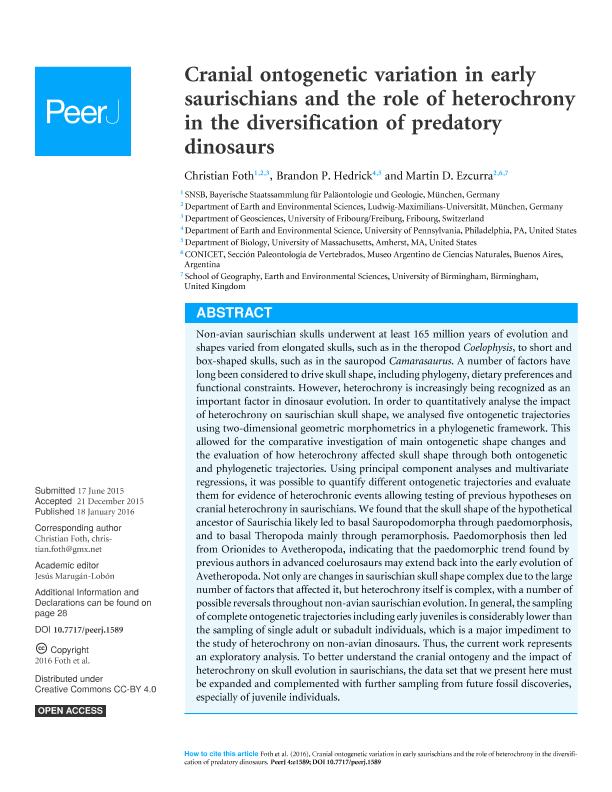Artículo
Cranial ontogenetic variation in early saurischians and the role of heterochrony in the diversification of predatory dinosaurs
Fecha de publicación:
01/2016
Editorial:
Corte Madera
Revista:
PeerJ
ISSN:
2167-8359
Idioma:
Inglés
Tipo de recurso:
Artículo publicado
Clasificación temática:
Resumen
Non-avian saurischian skulls underwent at least 165 million years of evolution and shapes varied from elongated skulls, such as in the theropod Coelophysis, to short and box-shaped skulls, such as in the sauropod Camarasaurus. A number of factors have long been considered to drive skull shape, including phylogeny, dietary preferences and functional constraints. However, heterochrony is increasingly being recognized as an important factor in dinosaur evolution. In order to quantitatively analyse the impact of heterochrony on saurischian skull shape, we analysed five ontogenetic trajectories using two-dimensional geometric morphometrics in a phylogenetic framework. This allowed for the comparative investigation of main ontogenetic shape changes and the evaluation of how heterochrony affected skull shape through both ontogenetic and phylogenetic trajectories. Using principal component analyses and multivariate regressions, it was possible to quantify different ontogenetic trajectories and evaluate them for evidence of heterochronic events allowing testing of previous hypotheses on cranial heterochrony in saurischians. We found that the skull shape of the hypothetical ancestor of Saurischia likely led to basal Sauropodomorpha through paedomorphosis, and to basal Theropoda mainly through peramorphosis. Paedomorphosis then led from Orionides to Avetheropoda, indicating that the paedomorphic trend found by previous authors in advanced coelurosaurs may extend back into the early evolution of Avetheropoda. Not only are changes in saurischian skull shape complex due to the large number of factors that affected it, but heterochrony itself is complex, with a number of possible reversals throughout non-avian saurischian evolution. In general, the sampling of complete ontogenetic trajectories including early juveniles is considerably lower than the sampling of single adult or subadult individuals, which is a major impediment to the study of heterochrony on non-avian dinosaurs. Thus, the current work represents an exploratory analysis. To better understand the cranial ontogeny and the impact of heterochrony on skull evolution in saurischians, the data set that we present here must be expanded and complemented with further sampling from future fossil discoveries, especially of juvenile individuals.
Archivos asociados
Licencia
Identificadores
Colecciones
Articulos(OCA PQUE. CENTENARIO)
Articulos de OFICINA DE COORDINACION ADMINISTRATIVA PQUE. CENTENARIO
Articulos de OFICINA DE COORDINACION ADMINISTRATIVA PQUE. CENTENARIO
Citación
Foth, C.; Hendrick, B. P.; Ezcurra, Martin Daniel; Cranial ontogenetic variation in early saurischians and the role of heterochrony in the diversification of predatory dinosaurs; Corte Madera; PeerJ; 4; 1-2016; 1-41
Compartir
Altmétricas




